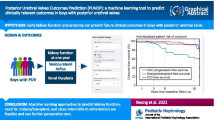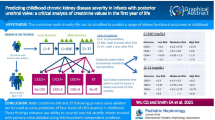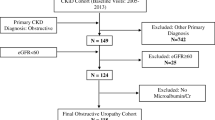Abstract
Background
We sought to use deep learning to extract anatomic features from postnatal kidney ultrasounds and evaluate their performance in predicting the risk and timing of chronic kidney disease (CKD) progression for boys with posterior urethral valves (PUV). We hypothesized that these features would predict CKD progression better than clinical characteristics such as nadir creatinine alone.
Methods
We performed a retrospective cohort study of boys with PUV treated at two pediatric health systems from 1990 to 2021. Features of kidneys were extracted from initial postnatal kidney ultrasound images using a deep learning model. Three time-to-event prediction models were built using random survival forests. The Imaging Model included deep learning imaging features, the Clinical Model included clinical data, and the Ensemble Model combined imaging features and clinical data. Separate models were built to include time-dependent clinical data that were available at 6 months, 1 year, 3 years, and 5 years.
Results
Two-hundred and twenty-five patients were included in the analysis. All models performed well with C-indices of 0.7 or greater. The Clinical Model outperformed the Imaging Model at all time points with nadir creatinine driving the performance of the Clinical Model. Combining the 6-month Imaging Model (C-index 0.7; 95% confidence interval [CI] 0.6, 0.79) with the 6-month Clinical Model (C-index 0.79; 95% CI 0.71, 0.86) resulted in a 6-month Ensemble Model that performed better (C-index 0.82; 95% CI 0.77, 0.88) than either model alone.
Conclusions
Deep learning imaging features extracted from initial postnatal kidney ultrasounds may improve early prediction of CKD progression among children with PUV.
Graphical abstract
A higher resolution version of the Graphical abstract is available as Supplementary information



Similar content being viewed by others
References
Krishnan A, de Souza A, Konijeti R, Baski LS (2006) The anatomy and embryology of posterior urethral valves. J Urol 175:1214–1220
Gunn TR, Mora JD, Pease P (1995) Antenatal diagnosis of urinary tract abnormalities by ultrasonography after 28 weeks’ gestation: incidence and outcome. Am J Obstet Gynecol 172:479–486
Heikkila J, Holmberg C, Kyllonen L, Rintala R et al (2011) Long-term risk of end stage renal disease in patients with posterior urethral valves. J Urol 186:2392–2396
Neild GH (2009) What do we know about chronic renal failure in young adults? II. Adult outcome of pediatric renal disease. Pediatr Nephrol 24:1921–1928
Groothoff J, Gruppen M, de Groot E, Offringa M (2005) Cardiovascular disease as a late complication of end-stage renal disease in children. Perit Dial Int 25:S123–S126
Groothoff JW (2005) Long-term outcomes of children with end-stage renal disease. Pediatr Nephrol 20:849–853
Groothoff JW, Offringa M, Van Eck-Smit BL, Gruppen MP et al (2003) Severe bone disease and low bone mineral density after juvenile renal failure. Kidney Int 63:266–275
Dodson JL, Jerry-Fluker JV, Ng DK, Moxey-Mims M et al (2011) Urological disorders in chronic kidney disease in children cohort: clinical characteristics and estimation of glomerular filtration rate. J Urol 186:1460–1466
Neild GH (2009) What do we know about chronic renal failure in young adults? I Primary renal disease Pediatr Nephrol 24:1913–1919
Heikkilä J, Holmberg C, Kyllonen L, Rintala R et al (2011) Long-term risk of end stage renal disease in patients with posterior urethral valves. J Urol 186:2392–2396
Drozdz D, Drozdz M, Gretz N, Mohring K et al (1998) Progression to end-stage renal disease in children with posterior urethral valves. Pediatr Nephrol 12:630–636
Lal R, Bhatnagar V, Mitra DK (1999) Long-term prognosis of renal function in boys treated for posterior urethral valves. Eur J Pediatr Surg 9:307–311
DeFoor W, Clark C, Jackson E, Reddy P et al (2008) Risk factors for end stage renal disease in children with posterior urethral valves. J Urol 180:1705–1708
Yin S, Peng Q, Li H, Zhang Z et al (2020) Multi-instance deep learning of ultrasound imaging data for pattern classification of congenital abnormalities of the kidney and urinary tract in children. Urology 142:183–189
Yin S, Peng Q, Li H, Zhang Z et al (2020) Automatic kidney segmentation in ultrasound images using subsequent boundary distance regression and pixelwise classification networks. Med Image Anal 60:101602
Zheng Q, Furth SL, Tasian GE, Fan Y (2019) Computer-aided diagnosis of congenital abnormalities of the kidney and urinary tract in children based on ultrasound imaging data by integrating texture image features and deep transfer learning image features. J Pediatr Urol 15:75.e1-75.e7
Zheng Q, Tasian G, Fan Y (2018) Transfer learning for diagnosis of congenital abnormalities of the kidney and urinary tract in children based on ultrasound imaging data. Proc IEEE Int Symp Biomed Imaging 1487–1490
Zhao X, Wu Y, Song G, Li Z et al (2018) A deep learning model integrating FCNNs and CRFs for brain tumor segmentation. Med Image Anal 43:98–111
Harris PA, Taylor R, Thielke R, Payne J et al (2009) Research electronic data capture (REDCap)–a metadata-driven methodology and workflow process for providing translational research informatics support. J Biomed Inform 42:377–381
He K, Zhang X, Ren S, Sun J (2016) Deep residual learning for image recognition. 2016 IEEE Conference on Computer Vision and Pattern Recognition (CVPR), 770–778. https://ieeexplore.ieee.org/document/7780459
Coresh J, Turin TC, Matsushita K, Sang Y et al (2014) Decline in estimated glomerular filtration rate and subsequent risk of end-stage renal disease and mortality. JAMA 311:2518–2531
Levey AS, Inker LA, Matsushita K, Greene T et al (2014) GFR decline as an end point for clinical trials in CKD: a scientific workshop sponsored by the National Kidney Foundation and the US Food and Drug Administration. Am J Kidney Dis 64:821–835
Warady BA, Abraham AG, Schwartz GJ, Wong CS et al (2015) Predictors of rapid progression of glomerular and nonglomerular kidney disease in children and adolescents: the chronic kidney disease in children (CKiD) cohort. Am J Kidney Dis 65:878–888
Pierce CB, Munoz A, Ng DK, Warady BA et al (2021) Age- and sex-dependent clinical equations to estimate glomerular filtration rates in children and young adults with chronic kidney disease. Kidney Int 99:948–956
Viteri B, Elsingergy M, Roem J, Ng D et al (2021) Ultrasound-based renal parenchymal area and kidney function decline in infants with congenital anomalies of the kidney and urinary tract. Semin Nephrol 41:427–433
Coleman R, King T, Nicoara C, Bader M et al (2015) Combined creatinine velocity and nadir creatinine: a reliable predictor of renal outcome in neonatally diagnosed posterior urethral valves. J Pediatr Urol 11:214.e1-e3
Coleman R, King T, Nicoara CD, Bader M et al (2015) Nadir creatinine in posterior urethral valves: how high is low enough? J Pediatr Urol 11:356.e1-e5
Kwong JC, Khondker A, Kim JK, Chua M et al (2022) Posterior urethral valves outcomes prediction (PUVOP): a machine learning tool to predict clinically relevant outcomes in boys with posterior urethral valves. Pediatr Nephrol 37:1067–1074
Vasconcelos MA, Silva AC, Gomes IR, Carvalho RA et al (2019) A clinical predictive model of chronic kidney disease in children with posterior urethral valves. Pediatr Nephrol 34:283–294
Funding
R21DK117297 NIH/NIDDK Anatomic Biomarkers of Chronic Kidney Disease, National Center for Advancing Translational Sciences of the National Institutes of Health under award number TL1TR001880 and 2UL1TR001878-06.
Author information
Authors and Affiliations
Corresponding author
Ethics declarations
Conflict of interest
The authors declare no competing interests.
Disclosures
None.
Additional information
Publisher's note
Springer Nature remains neutral with regard to jurisdictional claims in published maps and institutional affiliations.
Supplementary information
Below is the link to the electronic supplementary material.
Rights and permissions
Springer Nature or its licensor holds exclusive rights to this article under a publishing agreement with the author(s) or other rightsholder(s); author self-archiving of the accepted manuscript version of this article is solely governed by the terms of such publishing agreement and applicable law.
About this article
Cite this article
Weaver, J.K., Milford, K., Rickard, M. et al. Deep learning imaging features derived from kidney ultrasounds predict chronic kidney disease progression in children with posterior urethral valves. Pediatr Nephrol 38, 839–846 (2023). https://doi.org/10.1007/s00467-022-05677-0
Received:
Revised:
Accepted:
Published:
Issue Date:
DOI: https://doi.org/10.1007/s00467-022-05677-0




